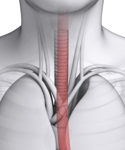Button battery impactions (BBI) in the esophagus represent a substantial risk to youngsters. For a study, researchers sought to explain how these individuals were treated before and after implementing guidelines at a particular center. A retrospective cohort analysis of patients with esophageal BBI at a single center, large volume, urban academic pediatric hospital system before (2007–2017) and after (2018–2020) the adoption of expert-opinion guidelines. The cohort consisted of 31 patients before the policies were adopted and 32 patients after the guidelines were adopted. There were no differences in patient characteristics between the groups. In 2018, acetic acid irrigation, initial cross-sectional imaging, and serial cross-sectional imaging were given to many patients. Intensive care unit (ICU) stays, number of intubations, nil per os time, and hospital duration of stay all increased. There was no difference in the results of the patients. The study looked at a large group of children with esophageal BBI before and after the recommendations were implemented. Increased adherence to guidelines resulted in more cross-sectional imaging, which led to more prolonged ICU stays longer lengths of stay, and more nil per os time, according to the outcomes. The research highlights the importance of multidisciplinary guidelines and more multi-institutional research.
Source:journals.lww.com/jpgn/Abstract/2022/02000/Evolving_Clinical_Care_in_Esophageal_Button.12.aspx


